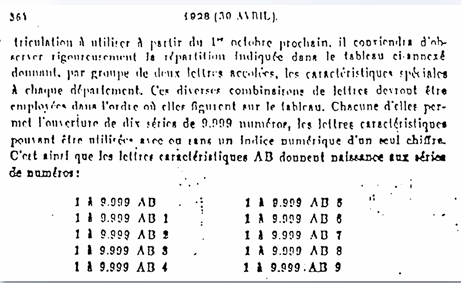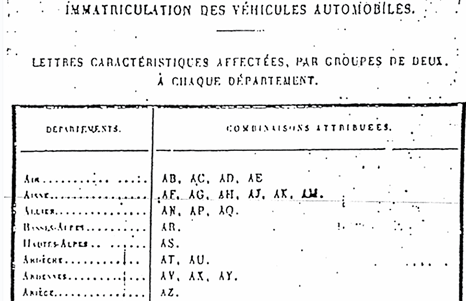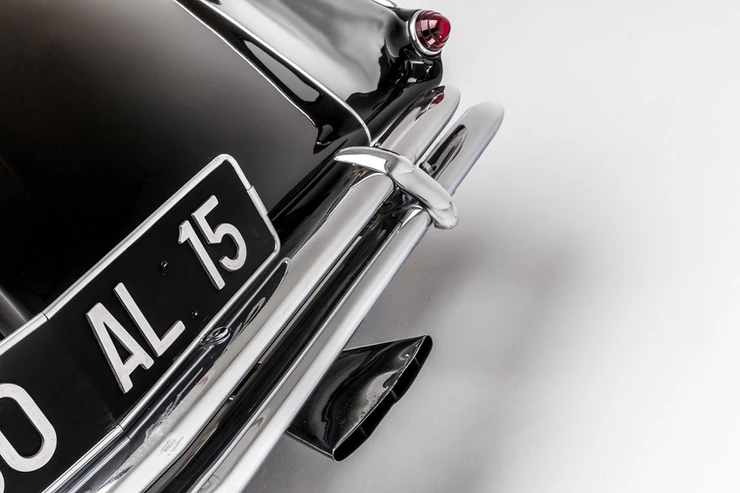History of Algerian license plates
- COCKPIT

- Mar 9
- 8 min read
Updated: 2 days ago
The invention of vehicles with combustion engines dates back to 1886 when the German Carl Benz created the Benz Patent Motorwagen, the first three-wheeled prototype with a combustion engine, while Gottlieb Daimler and Wilhelm Maybach presented their four-wheeled automobile with a four-stroke gasoline engine at the 1889 Paris World's Fair.
Since then, the expansion of these machines has taken on a significant scale even if production is still artisanal, and these vehicles now share the road with existing means of transport and pedestrians. Suffice to say that the authorities were not yet ready to regulate this new mode of transport. The first automobiles circulated without license plates, something quickly resolved.
The origins of the license plate
It all started at the Parc de la Tête d’Or in Lyon, France in the 19th century. In 1891, in the heart of Lyon’s green lung, the very first registration system was introduced. At that time, the park was open to motorists who could drive freely. Following accidents and inconveniences caused by cars in the park, including one where a 14-year-old boy fled with his vehicle after running over a civil servant, the Mayor of Lyon decided to make it mandatory for those who wanted to enter the Parc de la Tête d’Or by car to wear a plate with a unique identification number in exchange for their name and address. This “temporary” plate was affixed to the vehicle for the duration of the drive through the Park. The plates were then returned upon exiting. But the idea of identifying vehicles was not new, a decree of the Council of King Louis XVI may have inspired it: in 1783, coachmen had to apply metal plates to their horse-drawn vehicles bearing the name and address of the owner of the horses.


And on August 14, 1893, France was the first country in the world to register its vehicles, the Paris police prefect instituted compulsory registration of cars "to automobiles with the order of the police prefect on the operation and circulation on public roads, in Paris and in the jurisdiction of the police prefecture, of vehicles with mechanical engines, other than those used for the operation of concessioned railways". It extended the wearing of the plate of the coupled cars by adding a distinctive "number" issued by the manufacturer: "Article 17. Any vehicle with mechanical engines will bear on a metal plate, in visible and legible characters, the name and address of its owner and the distinctive number stated in the authorization request. This plate will be placed on the left side of the vehicle; it must never be hidden." Let us add that the driver must always carry the booklet certifying the authorization of the vehicle. The decree regulating the circulation of automobiles, dated March 10, 1899, renews this requirement: “Article 7. […] Each car will bear in clearly visible characters: “The name of the manufacturer, the indication of the type and the serial number of the type; The name and address of the owner.” Obviously, this plate is only readable when stationary: its characters are very small (5 millimeters) and it is poorly placed.

In 1900, this registration system was extended to the entire city of Lyon. At that time, the plates were permanently assigned to the inhabitants of Lyon. Temporary plates were distributed to tourists for the duration of their stay. This system was naturally criticized. It was only a year later, on September 10, 1901, that a decree made it mandatory for the entire French territory to wear a registration plate on the front and back of the vehicle. This management of the registration system was carried out by the "Mines" department, upon receipt of the vehicles. You probably understand the term "number plate" better now.



In 1902, Italy and then Belgium followed France's example. Then it was England and Germany's turn.
America followed closely behind Europe, where license plates were becoming commonplace. New York made the plate mandatory from 1901, but without establishing precise specifications. It was therefore up to New Yorkers to create their own license plates until New York officially began manufacturing US plates in 1909. Massachusetts led the charge for official license plates: it began issuing plates in 1903.
But it was in 1898 that the Netherlands became the first country to set up a national vehicle registration system. The first plates were simple plates with a number affixed to them. The numbering began with 1, and on August 8, 1899, it had already reached 168.
In Algeria
Algeria was then colonized by France and the territories of the former regency of Algiers became three French departments in 1848 (Oran department in the west, Algiers department in the center and Constantine department in the east). In 1902, the 6 Saharan territories formed the Southern Territories. They were administered by the 3 departments (2 territories each).
Thus, the registration of vehicles in Algeria is the responsibility of the French administration and the territories of northern Algeria have their own departmental numbers.
On September 16, 1901, the first French registration system began. The management of this system is carried out by the Mines department, upon receipt of the vehicle. This service is distributed in fifteen administrative regions called mineralogical districts, that of Marseille including in the first years the 3 regions of North Africa (Algeria, Morocco and Tunisia) as well as Monaco.
One of the obligations of the Mines service, in addition to the allocation of vehicle registration, is to ensure that they do not exceed 30 km/h, otherwise a stop will be installed to limit its speed. This number must be readable day and night. Despite this, some recalcitrant motorists oiled the rear plate without moderation and, thanks to the dust that stuck to the plate thus oiled, it became illegible. Before the publication of the decree above, a decree of March 10, 1899 required vehicle owners to register at the Prefecture of the department by specifying the vehicle, its chassis number and of course the name of the owner.

Algeria received the code AL in 1902.

In 1928, a new French system replaced the first in 1928. It kept its regional character with geographical codes but the allocation of plates was no longer the responsibility of the Mines Administration, but of the prefectures which already managed the registration cards. The new codes did not use the letters I and O, because they could be confused with other characters, nor the W which was reserved for vehicles on sale.


Double letters are also excluded, as they were used by the old system which remained in force until 1955 for cars registered before 1928. Letters which form the code of a country, for example GB for Great Britain, are also excluded, as are the letters assigned to the territories of North Africa (AL, MA and TU). Codes are assigned to departments in alphabetical order.





In 1951, new major changes in vehicle registration
The 1950 format takes up the departmental characteristic of the 1928 system but replaces the letters with numbers, which allows in particular to increase the possible combinations.
In Algeria, new automobiles will no longer be registered "AL" as of June 1, 1951 and the first cars whose license plates will bear the new numbering.

These two letters AL will be replaced by the numbers 91 (Algiers), 92 (Oran), 93 (Constantine), 94 (Territoires du Sud) and these 4 departments have used for 12 years the same type of numbering as in metropolitan France.
Indeed, the reform introduced a year ago in metropolitan France has just been applied to the Algerian departments. Thus, taking over from the number "90", Territoire de Belfort (formerly "BZ"), the "AL" will be replaced by the numbers "91", department of Algiers; "92", department of Oran; "93", department of Constantine and "94", Territoires du Sud.
On the other hand, these permanent numbers (91, 92. 93 and 94) will be preceded by three numbers and two letters at most. The first car registered in the department of Algiers on June 1 will therefore bear the number "1 A91".
The series will go up to the number "999 A 91", then go to "1 B 91". When you get to "999 Z 91", you will start again with two letters, "1 AA 91", "1 AB 91", and so on, to end with "999 ZZ 91".

However, the "AL" will not disappear, the new registration is not mandatory for cars currently in circulation.
On the other hand, any purchase of a new car or transfer requiring a new registration card will imply, from June 1st, the change of numbering.
It should be noted that this new numbering has no connection with the general census of motor vehicles, the provisions of which we recall below.

In 1957, with a new division, thirteen new departments were created. Algiers 91 becomes 9A. Oran 92 / 9G, Constantine 93 /9D and Southern Territory 94 / 9 T then added: Batna 98B, Bone 9C, Médéa 9E, Mostaganem 9F, Orléanville 9H, Sétif 9J, Tiaret 9K, Tizi Ouzou 9L, Tlemcen 9M, Aumale 9N, Bougie 9P, Saida 9R, Oasis 8A and Saoura 8B.
1959, Abolition of the departments of Aumale and Bougie, with changes to the boundaries of the
departments of Batna, Bône, Constantine, Médéa, Oran, Saïda and Sétif.
1961, Implementation of 2 new department codes, 8A and 8B to replace 9T.



1962, independence of Algeria and new Algerian regulations in 1963



After independence in 1962, the 15 departments (9A, 9B, 9C, 9D, 9E, 9F, 9G, 9H, 9J, 9K, 9L, 9M, 9R, 8A, 8B) continued until 1978 (their codes were used until 1964).
The new decree defining the new Algerian registration plates in 1963 is below.


Defined: CT Technical Cooperator, TT Temporary Transit, CD Diplomatic Corps, AL Local Administration, DP Police Directorate.




















1975, the terms of the new license plates still in force with changes over time
First change that can be seen, the colors of the plates become white in front and yellow behind with black characters instead of the black background and white writing. We will note in particular the removal of the word El-Djazair (الجزائر).
The registration number is now composed (from right to left) of 3 groups of diagrams (set of numbers):
- a diagram representing the wilaya of registration (from 1 to 58);
- of a group of three (3) Arabic numerals, separated from the previous one by a space, characterizing the year of entry into circulation (the first two digits) and the category of the vehicle (the third digit).
The Arabic numerals representing the category of vehicles.

Here is the latest version of Algerian license plates (click here)






























Comments